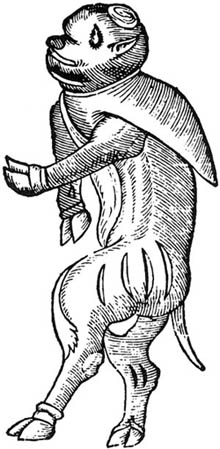A Monstrosity and a Skeptic
Today, guest historian Cathy Patterson gives birth to a cat. The University of Houston presents this series about the machines that make our civilization run, and the people whose ingenuity created them.
In 1569, Agnes Bowker, an English servant girl, told an unsettling story. Agnes had, she said, after a long and difficult pregnancy, given birth to a cat. Impregnated by magical means, by figures that came to her in the form of animals, this poor young woman experienced a birth of a monstrous kind.
Was Agnes delusional? A liar? Today, we assume she must have been one or the other. But in the 16th century, people were not so sure. A woman giving birth to a cat was not normal, but it was not thought impossible, either. It might be a work of witchcraft, or it might be a portent of God's wrath.
Educated gentlemen and illiterate serving girls alike considered magic -- both good and bad -- to be very real. Monstrous births, lucky charms, and acts of malicious magic were all believed to exist and to have supernatural meaning.
So how did contemporaries interpret Agnes's disturbing tale? We might assume that Agnes's story of magical intercourse with the devil's minions would lead to an accusation of witchcraft. But in fact, this was not the case.
The women who attended her in the birth room at first fled in terror, but later they doubted whether the cat had actually come forth from Agnes. Was the midwife in cahoots? Had she duped everyone? A group of local men, a practical-minded lot, examined and disemboweled the "monster". It was, they declared, just a dead cat. Yet because of its strangeness, they reported the case to higher authorities.
A church official, Anthony Anderson, questioned Agnes and her neighbors closely. While he could not pin down all the details of girl's story, he investigated the cat thoroughly. Wild tales of the monstrous cat had made their way rapidly into print, and Anderson took pains to quell the rumors. The so-called monster was simply a barnyard cat, he said. To prove his point, he drew a detailed picture of the animal, saying that it "containeth the full length, thickness, and bigness of the same . . . measured by a pair of compasses." He also experimented by having another cat autopsied and comparing the two. They were, he stated, precisely the same, except for eye color.
This image -- a 16th-century Crime Scene Investigation -- reveals Anderson's "scientific" perspective. He did not assume that the girl was bewitched, or a witch herself. Instead, he sought to untangle real from unreal. Agnes's story was strange, but he clearly thought her pregnancy resulted from human, not supernatural, means. Magic had a place in his mental universe, but it was not the only explanation for strange events.
We tend to tell one another that people of long ago were driven by superstition until the Enlightenment gave us science. But the story of Agnes Bowker and her cat reveals far more complicated thinking. Even 400 years ago, skepticism could trump the supernatural. And given the popularity today of the National Enquirer and psychic hotlines, are we really so far from those English villagers?
I'm Cathy Patterson, at the University of Houston, where we're interested in the way inventive minds work.

Cathy Patterson is Associate Professor of History and Associate Dean of the College of Liberal Arts and Social Sciences at the University of Houston. She is author of Urban Patronage in Early modern England: Corporate Boroughs, the Landed Elite, and the Crown, 1580-1640.(Stanford: Stanford University Press, 1999)
Agnes Bowker's tale is told by historian David Cressy in Agnes Bowker's Cat: Travesties and Transgressions in Tudor and Stuart England(Oxford: Oxford University Press, 2000)
For more on changing beliefs in magic in the early modern period, see Keith Thomas, Religion and the Decline of Magic. (London: Weidenfeld and Nicolson, 1971 [and reprinted many times since])
The image, above and right, of a supposed monstrous birth from a book by Bowker and Anderson's contemporary, Ambroise Paré, On Monsters and Marvels, 1573.